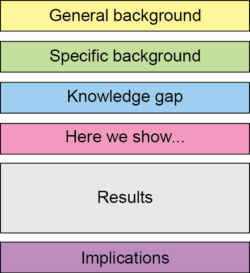Criteria for success
- General Background/State-of-the-field. What does everyone in your audience care about? Set up the big-picture background that motivates your problem.
- Specific Background. Bring the reader into the more nuanced discussion that you’re opening up.
- Problem Statement or Knowledge Gap. What’s the actual problem you’re addressing? What’s lacking in the current field or approaches? Use a pivot word like “however” to set up the contrast with the existing knowledge base.
- Here we show. One sentence about what you learned or did, and how that addresses the problem you set up.
- Approach & Results. What’s the high-level approach that you used? What did you find? (Be quantitative!)
- Implications. So what? What do your results mean for the thing everyone cares about? Where does the research lead from here?
Structure Diagram
In some cases, the different sections can be intertwined, but most of the times, this structure will be the easiest for your reader to parse:

Purpose
Your abstract is your sales pitch for your work. When browsing a journal, very few readers get beyond the title and abstract for any article. If you haven’t convinced your reader by the end of the abstract that your work is interesting and relevant, you’ve lost the opportunity to convert them from curious browser to dedicated reader. The same goes for folks deciding which talks and posters to see at a busy conference.
In only a few hundred words—or, from your audience’s perspective, a few minutes of reading—you have to
- convince your reader that your work is addressing an authentic, pressing problem in science or engineering,
- convey the essence of your results,
- explain what those results mean for the state of the field and for future work.
Analyze your audience
Most people will take take only seconds to minutes to skim your abstract in order to decide whether they actually want to learn more about your work. If they don’t get hooked by your problem setup, your results won’t matter to them. Craft the background and problem statement so that they are interesting and relevant to the intended audience of this abstract.
For a specialized audience, you could lead with “Eigenspectrum analysis of stochastic state space models of nonlinear wave loads provide stability criterion for unconventional ships in extreme sea states.” For journals with broader readership, you would need to start with something everyone cares about, say, “As ship designers are turning more and more to unconventional hull geometries, understanding the nonlinear ocean wave excitations is critical to analyze the stability of any vessel, from a passenger ferry to an aircraft carrier, operating in extreme sea states.”
Skills
Avoid jargon
Don’t rely on technical names; explain what something is or why it matters for your work. If by “manufactured using a Form 2” you really mean “3D printed”, just say “3D printed.” Rather than “Wiener cascade model”, you might say “a nonlinear system model (Wiener cascade)”. In this way, you speak to the general audience (who can understand “a nonlinear system model”) and to your specialist peers (who would ask, “Which nonlinear model?”).
Be critical of any jargon you include, and remove any that is not essential to conveying your high-level message. Consider asking a friend in a different lab to read over your abstract and point out any terms that obscure your meaning.
Use the standard abstract formula
Every successful abstract has six components. Refer to the Criteria for Success above. Each component should only have a few sentences.
